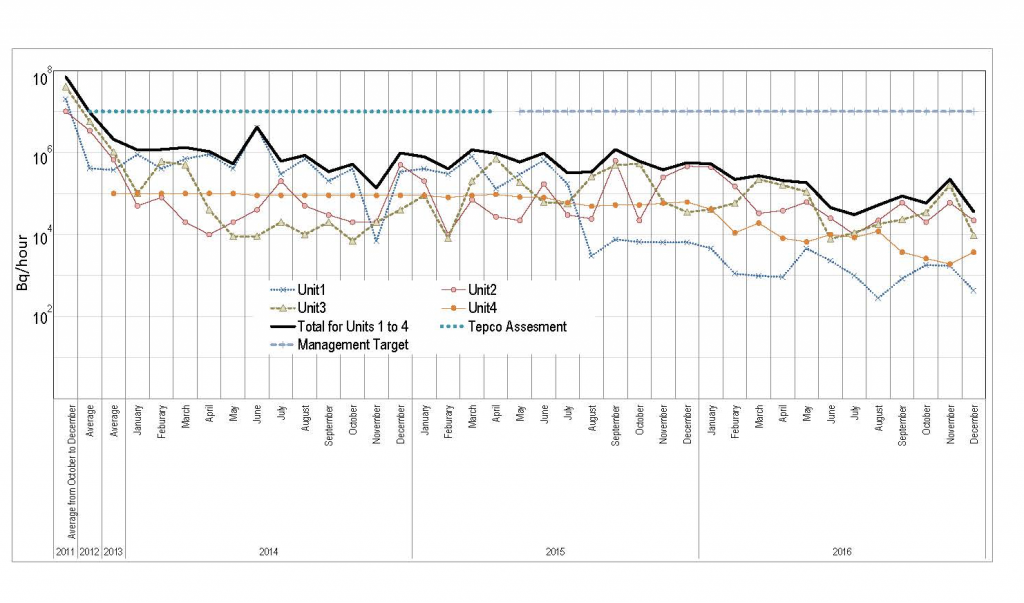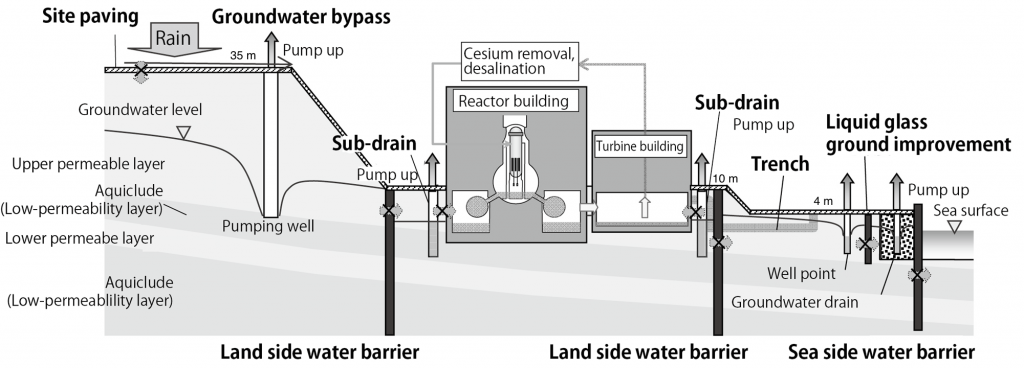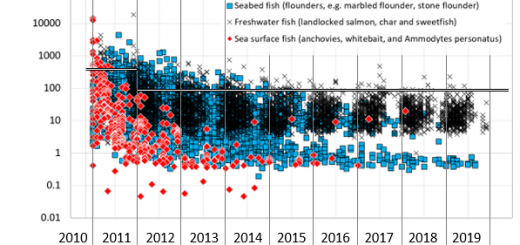Current State of Post-Accident Operations at Fukushima Daiichi Nuclear Power Station (August to December 2016)
State of the Plant
From the water temperature in the containment vessels and the spent fuel pools (SPFs), and from the state of releases of Xenon-135, which is released when uranium undergoes fission, and other measurements, it can be estimated that the state of the reactors is stable. Moreover, according to a TEPCO assessment, around 40,000 bequerels per hour (Bq/h) of radioactive materials were being released in December (see Figure 1). This is a considerable improvement when it is recalled that this figure was 560,000 Bq/h in December 2015.
Figure 1: Releases of radioactivity from Units 1 to 4 of Fukushima Daiichi Nuclear Power Station (Ministry of Economics, Trade and Industry website)
The situation regarding the removal of spent fuel from the SPFs
Except for Unit 4, from which fuel removal has been completed, the SPFs of all other units are now being prepared for fuel removal. The important advance has been the completion on November 11 of removal work for the cover side panels on the Unit 1 reactor building. The installation of a shield on the operating floor of Unit 3 was also completed on December 2. The reduction of the dose rate on the operating floor of Unit 3 had not proceeded as expected, and the removal of spent fuel has been postponed to around the middle of FY2018 from the original FY2015.
State of the Frozen Earth Barrier (On-land water barrier) (see Figure 2)
As one part of the contaminated water countermeasures, the government and TEPCO have installed a frozen earth barrier (on-land water barrier, total length 1,500m), which encloses Units 1 to 4 at Fukushima Daiichi Nuclear Power Station (FDNPS). Freezing has been implemented in three stages. The first stage consisted of two phases, phase 1 (begun on March 31), in which freezing work was carried out for the whole of the sea side (690m), a part of the northern section of the mountain side (130m) and 77 priority freezing locations (290m), and phase 2 (begun on June 6), in which freezing work was carried out for the whole barrier (sea side, roughly 690m; mountain side, roughly 860m) except for seven locations on the mountain side (45m). As a result, temperature measurements using the side temperature tubes (installed at 5m intervals, roughly 85cm from the barrier) showed that 100% of locations on the sea side and 95% or more of locations on the mountain side had reached temperatures of 0ºC or lower in late October. In the second stage, begun on December 3, freezing work is being carried out in two locations of those not yet frozen on the mountain side. The third stage will be the full freezing of the mountain side barrier.
According to TEPCO, as of December 2016, groundwater influx to the mountain side surroundings of the frozen earth barrier was 680m3/day, the amount pumped up from the subdrains around the buildings was 510m3/day, water actually flowing into the buildings was 140m3/day, and water pumped up from the sea side 4m base (the ground level at the sea side of the NPS buildings) was 170 m3/day. Further, of the water pumped up from the 4m base, a part of the most contaminated water was fed into the turbine building. The amount pumped up from the 4m base fell slightly below 192 m3/day, the lowest figure before the freezing of the frozen earth barrier.
TEPCO says that the reason for the reduction was a complex combination of effects, such as measures to prevent infiltration of rainwater, operation of the subdrains, full-scale freezing of the sea side frozen earth barrier, and so on. Originally, TEPCO had aimed at a pumped volume of 70m3/day, but the among the reasons given for the volume not falling that far were 1) the possibility that the flow of groundwater to the 4m base, which is linked with the alternately-layered non-frozen location in the lower part of the sea water pipe trench, was greater than expected, 2) impacts of the structures that pass through the frozen earth barrier, and 3) the possibility that the permeability of the sea side water barrier was lower than expected.
The Nuclear Regulation Authority (NRA) had originally feared that if, when the frozen earth barrier was operated, the groundwater level fell below the water level of the contaminated water in the buildings, contaminated water would leak out into the groundwater. Toyoshi Fuketa, acting NRA chairman, stated at the 49th meeting of the Specific Nuclear Facility Supervision and Assessment Review Committee, however, that “Since the water barrier is letting this much water through on the sea side, it must certainly be letting water through on the mountain side as well,” thus acknowledging that he sees that the effectiveness of the frozen water barrier is limited.
Figure 2: Groundwater measures at FDNPS (TEPCO website, with additions)
State of Onsite Water Tanks
As of December 2016, 1,001 tanks were storing contaminated water onsite. Of these, there still remain 219 flange-type tanks, which have experienced problems with leakage of contaminated water. TEPCO has said that the target for dismantling all flange-type tanks is March 2019.
(Hajime Matsukubo)
List of Accidents at FDNPS, August to December 2016



